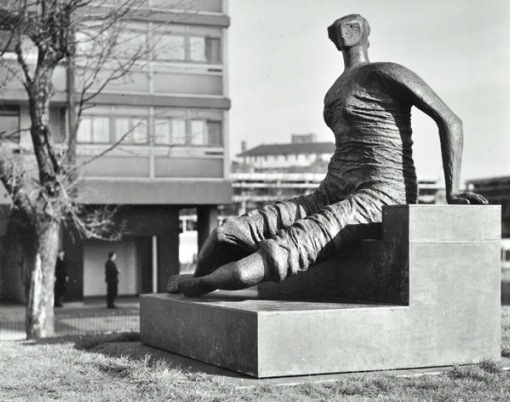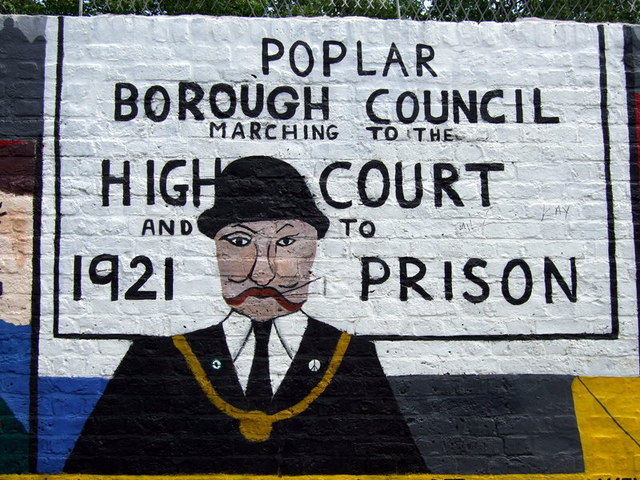For the latest in my series exploring the practice of urban historians at work today, I was lucky enough to be able to catch up with Rosamund West, museums professional and PhD student at Kingston University. Rosamund’s PhD explores, partly through utalising a range of public engagement approaches, the ways in which the London County Council’s public art policies worked their way-not just into London’s fabric-but the fabric of Londoner’s lives.
What is your background?
I am South-East London born and bred, and so the subject of my research is possibly not the most adventurous! I did a BA and a part time MA in History of Art at the University of York, and really loved my time there. My BA dissertation was on the post-war rebuilding of the Elephant and Castle and my MA dissertation was on two London County Council (LCC) estates that had artworks installed on them. In between, and at the same time as studying, I have worked in a number of museums in London and Yorkshire.
What led you to choose your subject matter?
“…growing up I was dazzled by the bright pink of the Elephant’s shopping centre, and loved the splashes of colour in subways and on walls around London.”
I went into my degree wanting to study the architecture and planning of the Elephant and Castle. I have known the Elephant my whole life and have family connections to the area. Growing up, people would say how ugly it was and how it had been ruined. As I got older, I wandered why the environment was like it was, why you had to go under the ground to cross from one side of the roundabout to another, who ‘ruined’ it, and why?
Also growing up I was dazzled by the bright pink of the Elephant’s shopping centre, and loved the splashes of colour in subways and on walls around London. I particularly noticed the colourful murals, often political, on the end of terraces around my local area. As a child, the motivation and meaning of them was lost on me but I loved how colourful they were and how I could see familiar people in them.
Is there anyone (historian or otherwise) that particularly inspires your approach to your topic?
“An approach I always try to bear in mind is how would family and friends who experienced LCC policies react to my research?”
There are a lot of historians doing research into post-war architecture and planning, which is great as it stimulates more work and more interest in the area. I recently joined twitter and have been blown away by how supportive people have been in showing an interest in my work, in pointing me towards articles, and in helping me find sources. I have found the wider community of historians, enthusiasts and professionals to be a generous and supportive one.
An approach I always try to bear in mind is how would family and friends who experienced LCC policies react to my research? When I speak about my research, reactions range from bemusement to a real enthusiasm to talk about the effect the LCC had on them. Presenting research to people that experienced what you are talking about is a useful challenge, I find.
What do you hope that readers take away from your work?
“I… hope to share my work and increase access to the history of London and the LCC by talking about it outside in the environment, not just writing about it.”
I hope readers find the post-war re-planning of London engaging as it affects many of us in our daily lives. I hope people see how optimistically London was planned, and how the original vision, the original ideas, were intended to make London a better place to live in for Londoners. I hope people get a sense of how a municipal authority was providing housing so desperately needed, while at the same time being concerned about people’s cultural enrichment and education.
I also hope to share my work and increase access to the history of London and the LCC by talking about it outside in the environment, not just writing about it. I have taken people on tours of the Lansbury estate in Poplar, which I love doing, as I get to talk about an (apparently everyday) environment with people and respond to their questions, opinions and memories. I find this way of working so beneficial to my research, especially when former and current residents come along and fill in gaps for me!
How has your work evolved over the course of your project?
Going right back to my BA, a big change I have noticed is how easy it is now to take photographs of an everyday urban environment. We now all have camera phones and use social media, so taking photographs all the time is normal. When I began studying and taking photographs of the Elephant and Castle around 2005, a lot of my photographs have my Dad in. It felt intrusive taking photos around people going about their daily business, so I pretended I was taking photos of my Dad. Consequently, he is in a lot of my dissertation photographs of the Elephant!
“For the LCC, art was not an elitist pursuit, but a part of daily life.”
Another way my work has evolved is that I cannot fail to ignore current housing and arts policies as they become increasingly remote from the post-war consensus. How people are housed, and attitudes of politicians and the media to people that need housing, are a world away from the policies and rhetoric of the LCC. Cuts to arts funding and arts education are also a huge departure from the post-war LCC. The LCC was installing artworks by artists such as Henry Moore, Elizabeth Frink, and Franta Belsky within everyday housing environments. They believed in the value of the arts and the value of arts education. For the LCC, art was not an elitist pursuit, but a part of daily life.
Whilst researching, what sources have you found most illuminating?
My absolute favourite source is LCC publications themselves. The LCC wrote about themselves a lot! The way they are so proud of their achievements and write in such a totally optimistic way about the LCC is fascinating. The LCC publications directly address Londoners and are sentimental about London and Londoners; they see the romance in everyday London life. These publications are very revealing about what the LCC thought Londoners wanted and how they believed they were working in Londoner’s best interests.
How easy is it to trace the networks that enabled the creation of public art in post-war London
“I have… spoken to an artist who talked through his work with residents, but I want to know more.”
My holy grail is to find minutes, or some detailed descriptions, of the ‘client committees’ used to discuss an artwork. Representatives from the Arts Council, the LCC and a client committee would meet to discuss an artwork. The client committee would vary depending on whether the artwork was for a school, a housing estate, an old people’s home, or a park. I have found many references to the discussions and outcomes of the client committees, and have spoken to an artist who talked through his work with residents, but I want to know more. Later in my PhD, I hope to track down residents who remember speaking to artists or the LCC about artworks.
Do they appear to have changed over time?
Yes. Before the patronage of the arts programme really got going in 1956/57, the LCC were already installing artworks in residential settings. As early as 1949, Peter Laszlo Peri’s sculptural relief, Following the Leader (Memorial to the children killed in the Blitz) was installed on the Vauxhall Gardens estate. From 1956/57, the LCC set aside £20,000 a year for the scheme. The scheme morphs over time, and the LCC express concern over not exercising personal taste; seeking advice from the Arts Council; and the role of the client committees in assessing works.
Through my museum job, I identify with the LCC’s need to change and adapt their acquisition policy and process over time. The main purpose of my museum role is the complicated and varied process of acquiring objects and I attend the acquisition committee meetings. These same ethical and moral concerns over acquisitions are still relevant to practise today.
Is there anything that historians can learn from museum work and practices?
“Historians can learn from museum work and practise by utilising the power of objects to engage and inspire: nothing can replace looking at and touching an object, being in its physical space.”
In my museum career, I have delivered many handling workshops and talks involving objects, and witnessed how powerfully an object can evoke a period in history or a memory for a person. Such activities open up museum collections to the public, and increase access and knowledge to the collections. Historians can learn from museum work and practise by utilising the power of objects to engage and inspire: nothing can replace looking at and touching an object, being in its physical space. Architecture and the built environment is the same: to engage with it you need to be within the environment. This is especially relevant with my research as I am interested in how the LCC planned for communities, and why they installed artworks where they did, and so physically walking around the environment is crucial.

Henry Moore, Draped Seated Woman(‘Old Flo’), Stifford Estate, Stepney
You can find Rosamund on Twitter and she can also be reached through the Kingston University Faculty of Art, Design and Architecture graduate school. More urban history profiles can be read here.
